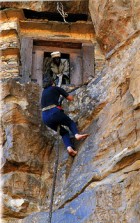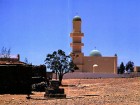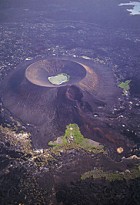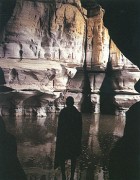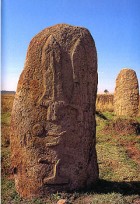Tourism | Popular Spot1 | Popular Spot2 | National Park | Tour Operators | Travel Advisories
Information on import & export or other Dealings in wildlife & wildlife production Ethiopia
CULTURAL ATTRACTIONS
Popular Spot 2
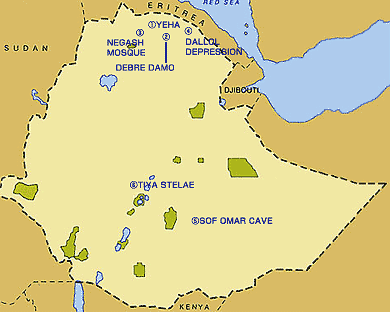
YEHA
Yeha is the center of the earliest civilization in northern Ethiopia. The journey takes you on rough tracks through the dramatic highland scenery and eventually ends in a beautiful and serene agricultural hamlet. It is there, close to a much more recent Christian Church that you may see the towering ruins of Yeha’s Temple of the moon built more than 2500 years ago in Sabaean times.
The temple is an imposing rectangular edifice. Through it has long since lost its roof and upper storeys the ruins stand some twelve metres in height. As evening falls, the temple’s finely dressed and polished limestone reflects the glow of the setting sun with warmth and brilliance that cannot be accidental. The huge, precisely fitted blocks from which the inward-including walls are formed seen to bear out ancient opinion that Sabaean buildings could be filled with water without a single drop being lost.
DEBRE DAMO
Damo is unique and unforgettable although, as with most Ethiopian monasteries. Women are not allowed to enter it. Even so, there is a daunting obstacle to the monastery: the only means of access is a climb of twenty-five meters up a sheer cliff. Monks lower a safety rope, which visitors tie around their waists. Then they used a second, thicker rope to climb with. Some may reflect, as they make their way to the top, that because of this arduous, dangerous ascent the art treasures of Debre Damo have remained intact through the monastery’s 1400 tumultuous years of history.
The treasures include and extensive collection of illuminated manuscripts-among them the oldest surviving fragments of texts anywhere in Ethiopia-and intricate carvings on the beams and ceiling of the ancient church around which the monastery is built, and a large number of paintings.
NEGASH MOSQUE
Negash is a small village located 60 km east of Mekele, the capital of Tigray Region. Anonymous with Islam as it is the place where the first mosque was constructed in Ethiopia. It also serves as enduring reminder of the warm welcome extended by the Ethiopian King of the time when those Muslims including the family of the prophet Mohammed fled persecution in their own land found refuge in Ethiopia during the early years of seventh century. Since then, Negash, has been a place of great historical and religious significance in a sense that it is a symbol of peaceful coexistence between Muslim and Christian religions.
DALLOL DEPRESSION
One of the most important features of this region of Africa is resulted from faulting and cracking eastern side. This has caused the Great Rift Valley, which extends from the Middle East to Mozambique, passing in a north-south direction right through Ethiopia. This shearing of the earth’s surface occurred at the same time that the Arabian Peninsula, geologically a part of Africa, was sundered from the rest of the continent. Volcanic activity, which has continued until today, finds expression in volcanoes in Ethiopia’s Danakil Depression, as well as in the hot springs in many parts of the country.
Danakil region is one of the Earth’s hottest and most inhospitable places. Parts are more than 100 meters below sea level and noon time temperatures sour to above 50 ?. After the Rift opened, much of this area was flooded by the in-rushing waters of the Red-Sea, a flood that was subsequently stemmed by reshlava. Behind these barriers, the trapped in landsea began to evaporate-a process that is a most complete.
SOF OMAR CAVE
The Sof Omar cave system, 120 km east of Goba in Bale region, is one of the most spectacular and extensive underground caverns in the world. Formed by the Weyb River as it changed course in the distant past and carved a new channel through limestone foothills, the 16 km cave system is an extraordinary natural phenomenon of breathtaking beauty.
The dry, cool caves contain many marvels of natural architecture, including soaring pillars of stone 20 meters high, flying buttresses, fluted archways and tall airy vaults. Finally the river itself is reached, flowing through a deep gorge. You can explore the caves on foot, without special climbing equipment, but proper precautions have to be taken. Torches or other lighting are needed and another must is a map. The most direct route through the first part of the caves takes about an hour. The large central hall of Sof Omar, the chamber of Columns’- so named after the colossal limestone pillars that are it’s dominant feature-is one of the highlights of the cave system.
TIYA STELAE
Tiya is one of the most attractive archaeological sites found in Ethiopia. The site is located 500 meters east of a small town called Tiya, in the Southern Nations, Nationalities and Peoples Regional State. It contains 36 monuments, including 32 carved stelae on which symbols are engraved. The site had a funerary function, hence, the stelae are surrounded by scattered graves. It is registered in the World Heritage List of the UNESCO.



